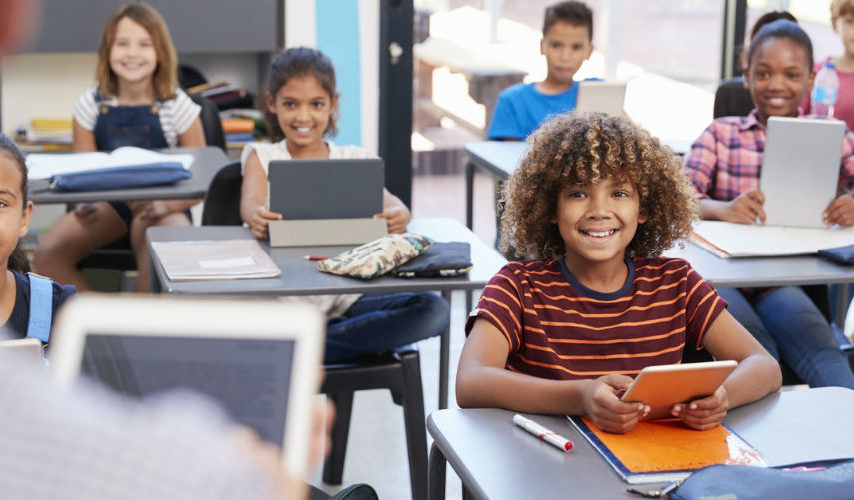The use of technology in the classroom is crucial for student engagement and empowers educators to create innovative learning experiences in class.
What does technology do for student learning? Some postsecondary teachers view technology as a distraction in the classroom. Although they won’t ban social media or mobile phones during lectures, some educators may view technology as more than a distraction.
After a year of learning remotely during the COVID-19 epidemic, things are starting to change. Instead of ‘tolerating’ it, instructors realize that technology and the power and potential of digital apps, tools, and devices can increase engagement, encourage collaboration and spark innovation, and enhance student learning.
Educational technology by itself is not enough to enable effective teaching and learning. It still needs a guide (the teacher) and a purpose (related to the curriculum). It takes effort and strategy to integrate technology into your course materials. Technology can be used to enhance student learning and productivity if it is used with intent.
These are some answers from Link Essay to the question about how technology has changed education and the reasons educators should make use of technology in the classroom.
Technology Allows for Easier Access to Resources
Access to information is available 24 hours a day via the Internet. You can find nearly anything online in the most current version. This means students have access to all kinds of resources, including educational apps and research materials. However, students may need guidance on how to locate credible resources and how to properly attribute their use.
Students can supplement their learning by joining online communities and groups in real-time, or by working together on group projects with tools like wikis or cloud-based apps. Instructors can also provide students with access to course materials and additional resources by creating portals in learning management systems or giving each learner access to course-specific software. Open educational resources can be a good option for educators who are budget conscious. They may have useful course material that students can access throughout the course.
What is an Open Educational Resource?
Open educational resources (OER), are learning, teaching, and research resources that others can use, keep, and distribute. Teaching resources with an open copyright license, such as Creative Commons, or that are part of the public domain without copyright are called. OER can be freely used, re-mixed, and improved depending on the license. OER can be used to engage students in learning beyond static chapters and lectures. Open educational resources combine technology with education to give instructors the tools they need to engage students in creating learning materials.
Technology can Increase Student Engagement
Technology is a tool that can be used to help students make learning more fun and collaborative. Instead of memorizing facts, students learn through doing and critical thinking. It could be as simple as participating in group discussions or taking interactive quizzes in class. It could also be as complex as participating in group discussions, playing educational games, or practicing science experiments in a virtual laboratory.
Interactive learning is key to making learning fun. Math done on a computer can be just as easy as doing it with a pencil, a pad of paper, or a pen and paper. However, using augmented reality to create animated math challenges is quite a different game. Interactivity and technology improve learning.
Technology in Education has many applications for educators. These include using simulation tools to show how a hurricane forms, and using virtual reality to perform medical procedures. Chris Hay Hurst, EdTech Magazine, writes that virtual reality is becoming more popular in medical schools. This allows students to better understand complex subjects such as anatomy. Blended learning can be a great way for you to make sure that your students are engaged in your class.
What’s Blended Learning?
Blended Learning teaches students online and through face-to-face instruction. Blended learning is sometimes referred to as hybrid learning. It combines traditional in-classroom education with online education with multimedia components such as polls and interactive discussions. Each has its advantages. Blended learning is a better learning environment for students because they can work with both their instructor and peers to reinforce learning and master the subject.
Blended learning goes beyond using technology to enhance the classroom experience. Blended learning is more than just using technology to enhance the classroom experience. It requires that a substantial portion of course material be delivered online via digital technology with some face-to-face components. Students can, for example, complete their homework online and have lab meetings in person. Students can complete some parts of the course on their own time and revisit it as often as they like. Students spend the rest of their time in classrooms, labs, or lecture halls with supervised instruction.
Technology can Extend Classroom Boundaries
Technology has made it possible to remove walls from the classroom. No boundaries exist in the learning environment. Instruction can be provided by many subject matter experts from the real world, in addition to the instructor through technology.
Students in rural U.S. classrooms can learn about the Arctic through the blog posts of scientists and view photos. They can also e-mail questions to scientists and chat live via videoconference with them. According to an article about technology in education written by Purdue University, students can share what they’re learning with other students in other states that are following the same expedition. Technology allows students to broaden their horizons beyond the classroom and connect it to the real world.
Technology Encourages Self-Paced Learning
Students who struggled to grasp new concepts in a traditional classroom would soon fall behind their peers. Students can learn at their own pace with self-paced learning elements. Students who require more help or time can practice outside the classroom with guided exercises and additional coursework. Learners who are looking for more challenges can also practice outside of class with guided exercises or additional coursework.
Students can easily access online learning resources due to the availability of technology at all times. These resources can also be used to help instructors identify students who might need additional assistance.
Students can learn 21st-century skills and digital literacy through self-paced learning. 1:1 computing is one way to achieve this goal. It provides students with all the technology they need for coursework.
What’s 1:1 computing?
One-to-1 computing, also known as “1 to 1”, is an educational method in which every student receives a tablet or laptop from their academic institution. This allows them to access the Internet as well as preloaded course materials, textbooks, and other resources. One-to-one computing makes use of the technology’s impact to create an environment where students have equal access to information. Because 1:1 computing imparts skills that are expected to be used on campus as well as in the workplace, it can also increase career readiness.
Technology Can Encourage Innovative Teaching Techniques
The way we access information and how we learn it is changing with technology. Technology makes the instructor less of a “sage on a podium” and more of an “instructor on the side”. This opens up the possibility of teaching innovations (including collaborative group work and flipped or hybrid classrooms). Classroom response systems can be used by instructors to assess student understanding, adjust paces and improve students’ problem-solving skills. Digital materials can also enhance learning by being more flexible, engaging, and more able to meet student needs.
What Digital Materials are used in the Classroom?
Students are intrigued by digital materials in higher education. These interactive textbooks and readings can increase student engagement and improve learning and comprehension. They include multimedia components, discussion threads, and embedded assessments. To foster deeper and more collaborative learning, many educators share their digital materials through chat forums, discussion threads, and comprehension-testing questions to assess student learning. Many educators have access to a variety of online learning tools, platforms, and materials that can be used to create tests, quizzes, and exams.
What does Technology mean for Student Learning? Summary
Technology is often seen as a danger, and it has its limitations. However, integrating technology into your teaching practices opens up new ways for students to interact with course material. This is particularly important after students are used to using technology to learn during the COVID-19 epidemic. Technology tools allow education to be extended beyond the classroom walls. YouTube videos and social media are not a distraction. They can be an integral part of your lesson plans. It’s simple math: better learning outcomes are possible.




